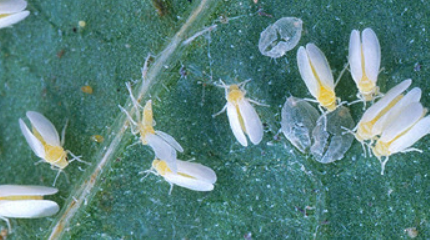A $4 Million USDA-ARS Partnership Explores Multidisciplinary Approaches to Mitigate the Menace
Unrelenting Threat: Silverleaf Whiteflies in the Southeast
Silverleaf whiteflies (Bemisia tabaci) have entrenched themselves as a formidable adversary to numerous economically vital crops across the Southeast, causing both direct damage through feeding and acting as vectors for over 100 plant viruses. As these “true bugs” persist and prove resistant to conventional control measures, a team of researchers at the University of Georgia College of Agricultural and Environmental Sciences (CAES) is at the forefront of unraveling their complexities.

A Multidisciplinary Pursuit
Led by Distinguished Research Professor Allen Moore from the UGA Department of Entomology, the multidisciplinary research team, comprising members from UGA, Fort Valley State University, and Auburn University, has secured a $4 million contract renewal with the USDA-Agricultural Research Service (ARS). Their mission is to deepen the understanding of silverleaf whiteflies and develop targeted interventions to safeguard vegetable production in the Southeast.
The Formidable Foe
Despite years of familiarity with silverleaf whiteflies, the industry faces an escalating emergency. With a combination of factors such as warmer winters, a broad host range, and asexual reproduction capabilities, whitefly populations surge rapidly. Compounding the challenge, very few crop varieties exhibit resistance to whiteflies and the associated viruses they transmit. Moreover, the insects’ elusive nature, predominantly found on the leaf undersides, complicates the efficacy of insecticide applications.
Beyond Conventional Pest Management
Traditionally, insecticide applications were the frontline defense against whiteflies, but their escalating resistance poses a significant challenge. Professor Moore describes them as “the worst pest you can possibly imagine.” The team is now exploring Integrated Pest Management (IPM) solutions, combining cultural practices, chemical controls, and biological interventions to diversify strategies and enhance planning.
Unraveling the Genetic Resistance
One facet of their research involves understanding genetic resistance and the evolution of insecticide resistance in Silverleaf whiteflies. Using molecular RNA-seq and RNAi, researchers aim to unravel the genetic mechanisms behind resistance to common insecticides, with the long-term goal of developing informed control strategies.
Immediate and Long-Term Strategies
The research team adopts a dual-pronged approach, addressing immediate needs while investing in long-term projects to comprehensively understand and manage Silverleaf whiteflies. Innovative solutions include the development of row-cover products by the Auburn team, reducing whitefly pressure and improving yield and insecticide efficacy.
Team Science: Accelerating Progress
A unique aspect of this research initiative is the implementation of team science. Instead of isolated efforts, a diverse research group collaborates, communicates, and problem-solves collectively. Professor Moore emphasizes that progress is more rapid when achieved collaboratively, with the hope that integrated teamwork will yield more substantial results.
Building Foundations for the Future
Looking ahead, the team underscores the importance of foundational research as the key to resolving the silverleaf whitefly problem. By leveraging collective expertise in genomics, molecular genetics, physiology, and insecticide resistance, the team envisions making accelerated progress toward sustainable solutions.
In essence, the battle against silverleaf whiteflies unfolds as a multifaceted endeavor, blending scientific disciplines, innovative technologies, and a collective spirit to safeguard the Southeast’s agricultural landscape. As the research progresses, the aim is not only to mitigate the immediate threat but to fortify the region’s resilience against future challenges posed by evolving pests.